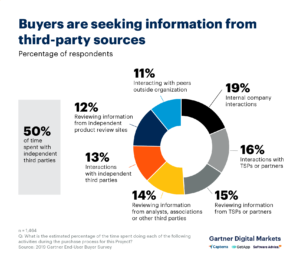Table of contents:
If you’re new to buyer intent data, it can be difficult to know where to start. Simply put, intent data is online information collected about a company to identify whether that company is actively considering purchasing your product or services. Buyer intent data combines first-party intent data, third-party intent data, and B2B buying signals. It can help you to extract the maximum possible ROI from your marketing campaigns and increase your sales.
To help you get to grips with this latest trend in B2B marketing, we’ve listed below 6 of the most essential facts you should know about buyer intent data:
1. Buyer intent data is generated by monitoring the internet for buying signals
Every time you publish content on social media, interact with others on social media or post jobs online, you send out signals that can be used to understand your business intentions. This can provide insight into what products or services you may research or require. These online signals are commonly referred to as ‘buying signals’.
B2B intent data tools can monitor the internet for these signals and discover new prospects talking online about your product or service. The software can also monitor when businesses engage with your competitors online – so you can target the right accounts at the right time.
B2B buying signals can be collected from:
- Social media sites such as LinkedIn and Twitter
- Third-party review sites
- Job sites
- Industry-related content
- Conference and event registration data
- Open-source blogs and content websites
- News sites
The most sophisticated buyer intent platforms will provide you with real-time data of the companies displaying these buying signals and can also provide the contact level information of the key decision-makers in that business.
2. Intent data can help you to create personalised B2B buyer journeys
One of the many advantages of using buyer intent data is that it helps you to personalise your B2B buyer journeys. If a prospect engages with a competitor, you can send a timely introduction introducing your services. If they are hiring for a key position, you know they may be growing, and you can tailor your outreach accordingly.
Tailored outreach, or personalisation, is essential in B2B marketing. According to statistics compiled by Forbes, 98% of marketers say personalisation advances customer relationships, and for 51% of marketers, personalisation is the number 1 priority. Impressive figures!
Buyer intent data can be used by your marketing team to create hyper-personalised, timely and relevant content.
3. 80% of companies report an uplift in revenue from personalisation
According to data from eConsultancy, 4 out of 5 companies report an uplift in revenue from personalisation. However, personalising content based on traits such as a prospects job title or industry is simply not enough in today’s ultra-competitive world.
Buyer intent data allows for personalisation based – not only on known conditions such as job title – but also based on prospects’ particular research and interests at a given time.
Combined with marketing and sales automation software, this creates a compelling use case for investing in buyer intent data.
To learn more about how buyer intent data can increase sales, check out our article.


